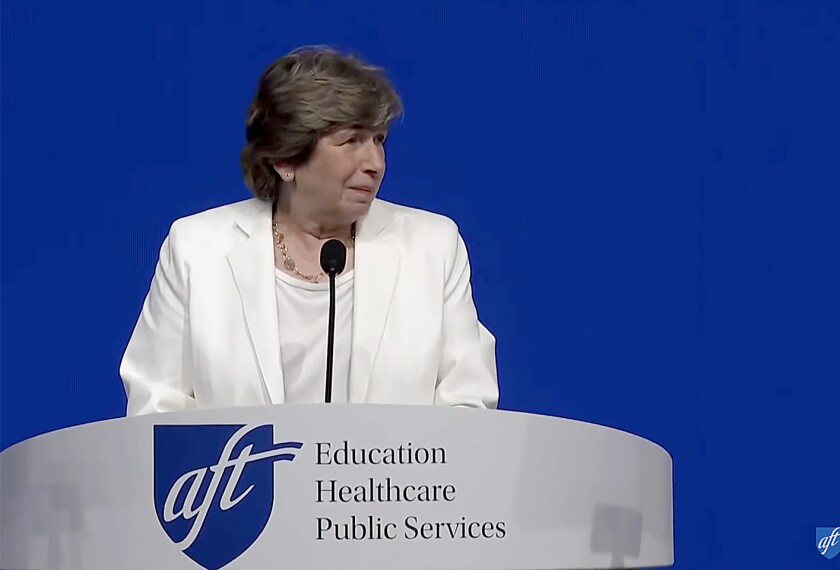Nearly all states continue to struggle in meeting the No Child Left Behind Act’s academic targets for English-language learners in mathematics and reading, according to the latest analysis released by the U.S. Department of Education.
Just one state—which is not named in the report but which an Education Department spokesman identified as Louisiana—is credited with hitting the mark for adequate yearly progress, or AYP, in math in the 2005-06 school year, the most recent year for which data was evaluated, while none met AYP in reading.
But while the biennial report sent to Congress on June 26 paints a gloomy picture on the two subjects for the nation’s estimated 5 million ELLs, it also shows the states doing somewhat better in the area of English-language proficiency.
Overall, 24 states—including California, Pennsylvania, and Texas—reported that ELLs were making progress in English. And 28 states, including Arizona, California, and Illinois, met the tougher standard for ELLs to attain proficiency in the language.
The report, based on data from the 2004-05 and 2005-06 school years, contains some conspicuous holes. That’s because much of the data submitted by states were incomplete, Jim Bradshaw, a spokesman for the Education Department, said in an e-mail message.
“The variation in how states implement [objectives required under NCLB] has made it difficult to report and interpret the state-reported data,” he said.
Mr. Bradshaw also said that federal education officials hope the interpretation of Title III, the section of NCLB governing programs for ELLs, that is expected to be finalized this summer will clarify questions that states have about carrying out learning goals and will lead to more consistent reporting of data across states.
Officials in some states have submitted comments to the department criticizing various aspects of the proposed interpretation published May 2 in the Federal Register, saying it will take flexibility away from people at the school district level in making decisions about English-learners.
Progress Reported
The report to Congress also draws on ELLs’ test scores on the National Assessment of Educational Progress from 2000 to 2007 to argue that such students have made some academic progress under the federal education law.
It says that over that period, the performance gap narrowed in 4th grade math as well as 4th and 8th grade reading between English-learners and other students who scored at “basic” proficiency or above.
But the report fails to note that the proportion of English-learners scoring as “proficient” in reading or math on NAEP—the bar that the federal education law says all students must reach on state tests by 2014—is very low. In 4th grade reading, for example, only 7.5 percent of English-learners scored at least “proficient” in 2007, while 35.5 percent of students who weren’t English-learners did.
New York—which has a large number of English-learners—didn’t submit most of the required data for the report about student progress. Mr. Bradshaw said that because of New York’s reporting problems, “conditions were placed” on some of the state’s Title III funding for 2007, and the state was required to submit a plan on how it would correct its reporting problems, which it did.
The report doesn’t say how many states made AYP in math or reading for the first of the two school years being evaluated. And it doesn’t give information about the different targets set by each state for making AYP or indicate how close states have come to meeting them.
Overall, the report says that 85 percent of the nation’s English-learners are participating in programs paid for with funds under Title III of the NCLB law. The department gave $580 million in state grants under Title III in the 2005-06 school year.
The failure of most states to make AYP for English-learners means that “the language-proficiency standards developed in most states are not developed to a high enough level where they can provide access to academic content achievement,” said Kathleen Leos, who resigned as the director of the Education Department’s office of English-language acquisition in fall 2007 and oversaw the production of early drafts of the report.
Data from states such as California show a standards gap for English-learners, she said. “Language acquisition doesn’t get them to the content achievement that is necessary. Those worlds have to come together.”
Progress Varies
The authors of the report point out that ELL achievement in math is slightly higher on average than achievement in reading.
Even so, fewer than half of such students tested proficient or above in math during the 2005-06 school year in 30 states. The proportion of ELLs testing at least proficient in math ranged from 4.7 percent in Missouri to 82.2 percent in Wyoming during the 2005-06 school year.
The report also notes that achievement in both math and reading drops as the grade level of students increases. “With each grade level,” the report says, “fewer states met their targets.”
The name of the report is “The Biennial Report to Congress on the Implementation of the Title III State Formula Grant Program: School Years 2004-2006.” The Education Department’s first two-year evaluation of Title III was released in March 2005. (“Federal Data Show Gains on Language,” March 23, 2005.)




